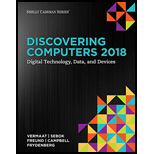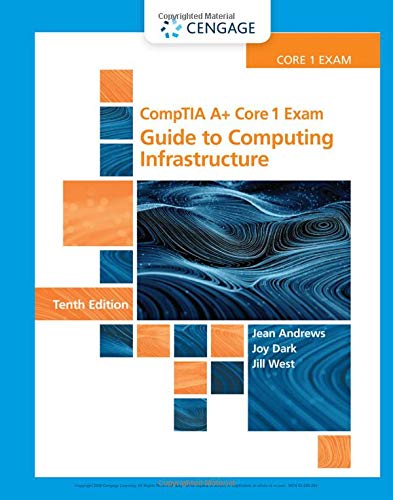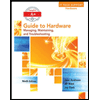
Discovering Computers ©2018: Digital Technology, Data, and Devices
1st Edition
ISBN: 9781337285100
Author: Misty E. Vermaat, Susan L. Sebok, Steven M. Freund, Jennifer T. Campbell, Mark Frydenberg
Publisher: Cengage Learning
expand_more
expand_more
format_list_bulleted
Concept explainers
Expert Solution & Answer
Chapter 6, Problem 1PS
Explanation of Solution
Given scenario:
A person is trying to connect a monitor to the computer, but the person finds that the ports are unable to recognize the connector which is present at the end of the monitor’s cable.
Steps taken to resolve the issue:
- The user needs to check the details of the port type that is present in the computer and monitor...
Expert Solution & Answer
Trending nowThis is a popular solution!

Students have asked these similar questions
1
Vo V₁
V3
V₂ V₂
2
1
Vo V₁
V3
V₂ V₂
2
Preparing for a test
Chapter 6 Solutions
Discovering Computers ©2018: Digital Technology, Data, and Devices
Ch. 6 - Prob. 1SGCh. 6 - Prob. 2SGCh. 6 - Prob. 3SGCh. 6 - Prob. 4SGCh. 6 - Prob. 5SGCh. 6 - Prob. 6SGCh. 6 - Prob. 7SGCh. 6 - Prob. 8SGCh. 6 - Prob. 9SGCh. 6 - Prob. 10SG
Ch. 6 - Prob. 11SGCh. 6 - Prob. 12SGCh. 6 - Prob. 13SGCh. 6 - Prob. 14SGCh. 6 - Prob. 15SGCh. 6 - Prob. 16SGCh. 6 - Prob. 17SGCh. 6 - Prob. 18SGCh. 6 - Prob. 19SGCh. 6 - Prob. 20SGCh. 6 - Prob. 21SGCh. 6 - Prob. 22SGCh. 6 - Prob. 23SGCh. 6 - Prob. 24SGCh. 6 - Prob. 25SGCh. 6 - Prob. 26SGCh. 6 - Prob. 27SGCh. 6 - Prob. 28SGCh. 6 - Prob. 29SGCh. 6 - Prob. 30SGCh. 6 - Prob. 31SGCh. 6 - Prob. 32SGCh. 6 - Prob. 33SGCh. 6 - Prob. 34SGCh. 6 - Prob. 35SGCh. 6 - Prob. 36SGCh. 6 - Prob. 37SGCh. 6 - Prob. 38SGCh. 6 - Describe how bus width and word size affect and...Ch. 6 - Prob. 40SGCh. 6 - Prob. 41SGCh. 6 - Prob. 42SGCh. 6 - Prob. 43SGCh. 6 - Prob. 44SGCh. 6 - Prob. 45SGCh. 6 - Prob. 46SGCh. 6 - Prob. 47SGCh. 6 - Prob. 1TFCh. 6 - Prob. 2TFCh. 6 - Prob. 3TFCh. 6 - Prob. 4TFCh. 6 - Prob. 5TFCh. 6 - Prob. 6TFCh. 6 - Prob. 7TFCh. 6 - Prob. 8TFCh. 6 - Prob. 9TFCh. 6 - Prob. 10TFCh. 6 - Prob. 11TFCh. 6 - Prob. 12TFCh. 6 - Prob. 1MCCh. 6 - Prob. 2MCCh. 6 - Prob. 3MCCh. 6 - Prob. 4MCCh. 6 - Prob. 5MCCh. 6 - Prob. 6MCCh. 6 - Prob. 7MCCh. 6 - Prob. 8MCCh. 6 - Prob. 1MCh. 6 - Prob. 2MCh. 6 - Prob. 3MCh. 6 - Prob. 4MCh. 6 - Prob. 5MCh. 6 - Prob. 6MCh. 6 - Prob. 7MCh. 6 - Prob. 8MCh. 6 - Prob. 9MCh. 6 - Prob. 10MCh. 6 - Prob. 2CTCh. 6 - Prob. 3CTCh. 6 - Prob. 4CTCh. 6 - Prob. 5CTCh. 6 - Prob. 6CTCh. 6 - Prob. 7CTCh. 6 - Prob. 8CTCh. 6 - Prob. 9CTCh. 6 - Prob. 10CTCh. 6 - Prob. 11CTCh. 6 - Prob. 12CTCh. 6 - Prob. 13CTCh. 6 - Prob. 14CTCh. 6 - Prob. 15CTCh. 6 - Prob. 16CTCh. 6 - Prob. 17CTCh. 6 - Prob. 18CTCh. 6 - Prob. 19CTCh. 6 - Prob. 20CTCh. 6 - Prob. 21CTCh. 6 - Prob. 22CTCh. 6 - Prob. 23CTCh. 6 - Prob. 24CTCh. 6 - Prob. 25CTCh. 6 - Prob. 26CTCh. 6 - Prob. 27CTCh. 6 - Prob. 1PSCh. 6 - Prob. 2PSCh. 6 - Prob. 3PSCh. 6 - Prob. 4PSCh. 6 - Prob. 5PSCh. 6 - Prob. 6PSCh. 6 - Prob. 7PSCh. 6 - Prob. 8PSCh. 6 - Prob. 9PSCh. 6 - Prob. 10PSCh. 6 - Prob. 11PSCh. 6 - Prob. 1.1ECh. 6 - Prob. 1.2ECh. 6 - Prob. 1.3ECh. 6 - Prob. 2.1ECh. 6 - Prob. 2.2ECh. 6 - Prob. 2.3ECh. 6 - Prob. 3.1ECh. 6 - Prob. 3.2ECh. 6 - Prob. 3.3ECh. 6 - Prob. 4.1ECh. 6 - Prob. 4.2ECh. 6 - Prob. 4.3ECh. 6 - Prob. 5.1ECh. 6 - Prob. 5.2ECh. 6 - Prob. 5.3ECh. 6 - Prob. 2IRCh. 6 - Prob. 4IRCh. 6 - Prob. 5IRCh. 6 - Prob. 1CTQCh. 6 - Prob. 2CTQCh. 6 - Prob. 3CTQCh. 6 - Prob. 4CTQ
Knowledge Booster
Learn more about
Need a deep-dive on the concept behind this application? Look no further. Learn more about this topic, computer-science and related others by exploring similar questions and additional content below.Similar questions
- 1 Vo V₁ V3 V₂ V₂ 2arrow_forwardI need help to solve a simple problem using Grover’s algorithm, where the solution is not necessarily known beforehand. The problem is a 2×2 binary sudoku with two rules: • No column may contain the same value twice. • No row may contain the same value twice. Each square in the sudoku is assigned to a variable as follows: We want to design a quantum circuit that outputs a valid solution to this sudoku. While using Grover’s algorithm for this task is not necessarily practical, the goal is to demonstrate how classical decision problems can be converted into oracles for Grover’s algorithm. Turning the Problem into a Circuit To solve this, an oracle needs to be created that helps identify valid solutions. The first step is to construct a classical function within a quantum circuit that checks whether a given state satisfies the sudoku rules. Since we need to check both columns and rows, there are four conditions to verify: v0 ≠ v1 # Check top row v2 ≠ v3 # Check bottom row…arrow_forwardI need help to solve a simple problem using Grover’s algorithm, where the solution is not necessarily known beforehand. The problem is a 2×2 binary sudoku with two rules: • No column may contain the same value twice. • No row may contain the same value twice. Each square in the sudoku is assigned to a variable as follows: We want to design a quantum circuit that outputs a valid solution to this sudoku. While using Grover’s algorithm for this task is not necessarily practical, the goal is to demonstrate how classical decision problems can be converted into oracles for Grover’s algorithm. Turning the Problem into a Circuit To solve this, an oracle needs to be created that helps identify valid solutions. The first step is to construct a classical function within a quantum circuit that checks whether a given state satisfies the sudoku rules. Since we need to check both columns and rows, there are four conditions to verify: v0 ≠ v1 # Check top row v2 ≠ v3 # Check bottom row…arrow_forward
- I need help to solve a simple problem using Grover’s algorithm, where the solution is not necessarily known beforehand. The problem is a 2×2 binary sudoku with two rules: • No column may contain the same value twice. • No row may contain the same value twice. Each square in the sudoku is assigned to a variable as follows: We want to design a quantum circuit that outputs a valid solution to this sudoku. While using Grover’s algorithm for this task is not necessarily practical, the goal is to demonstrate how classical decision problems can be converted into oracles for Grover’s algorithm. Turning the Problem into a Circuit To solve this, an oracle needs to be created that helps identify valid solutions. The first step is to construct a classical function within a quantum circuit that checks whether a given state satisfies the sudoku rules. Since we need to check both columns and rows, there are four conditions to verify: v0 ≠ v1 # Check top row v2 ≠ v3 # Check bottom row…arrow_forwardDon't use ai to answer I will report you answerarrow_forwardYou can use Eclipse later for program verification after submission. 1. Create an abstract Animal class. Then, create a Cat class. Please implement all the methods and inheritance relations in the UML correctly: Animal name: String # Animal (name: String) + getName(): String + setName(name: String): void + toString(): String + makeSound(): void Cat breed : String age: int + Cat(name: String, breed: String, age: int) + getBreed(): String + getAge (): int + toString(): String + makeSound(): void 2. Create a public CatTest class with a main method. In the main method, create one Cat object and print the object using System.out.println(). Then, test makeSound() method. Your printing result must follow the example output: name: Coco, breed: Domestic short-haired, age: 3 Meow Meowarrow_forward
- Q2) by using SHI-Tomasi detector method under the constraints shown in fig. 1 below find the corner that is usful to use in video-steganography? 10.8 ...... V...... 0.7 286 720 ke Fig.1 Threshold graph. The plain test is :Hello Ahmed the key is: 3a 2x5 5b 7c 1J 55 44 2X3 [ ] 2x3arrow_forwardusing r languagearrow_forwardWhat disadvantages are there in implicit dereferencing of pointers, but only in certain contexts?arrow_forward
arrow_back_ios
SEE MORE QUESTIONS
arrow_forward_ios
Recommended textbooks for you
 Comptia A+ Core 1 Exam: Guide To Computing Infras...Computer ScienceISBN:9780357108376Author:Jean Andrews, Joy Dark, Jill WestPublisher:Cengage Learning
Comptia A+ Core 1 Exam: Guide To Computing Infras...Computer ScienceISBN:9780357108376Author:Jean Andrews, Joy Dark, Jill WestPublisher:Cengage Learning A+ Guide To It Technical SupportComputer ScienceISBN:9780357108291Author:ANDREWS, Jean.Publisher:Cengage,
A+ Guide To It Technical SupportComputer ScienceISBN:9780357108291Author:ANDREWS, Jean.Publisher:Cengage, Enhanced Discovering Computers 2017 (Shelly Cashm...Computer ScienceISBN:9781305657458Author:Misty E. Vermaat, Susan L. Sebok, Steven M. Freund, Mark Frydenberg, Jennifer T. CampbellPublisher:Cengage Learning
Enhanced Discovering Computers 2017 (Shelly Cashm...Computer ScienceISBN:9781305657458Author:Misty E. Vermaat, Susan L. Sebok, Steven M. Freund, Mark Frydenberg, Jennifer T. CampbellPublisher:Cengage Learning A+ Guide to Hardware (Standalone Book) (MindTap C...Computer ScienceISBN:9781305266452Author:Jean AndrewsPublisher:Cengage Learning
A+ Guide to Hardware (Standalone Book) (MindTap C...Computer ScienceISBN:9781305266452Author:Jean AndrewsPublisher:Cengage Learning Systems ArchitectureComputer ScienceISBN:9781305080195Author:Stephen D. BurdPublisher:Cengage Learning
Systems ArchitectureComputer ScienceISBN:9781305080195Author:Stephen D. BurdPublisher:Cengage Learning

Comptia A+ Core 1 Exam: Guide To Computing Infras...
Computer Science
ISBN:9780357108376
Author:Jean Andrews, Joy Dark, Jill West
Publisher:Cengage Learning

A+ Guide To It Technical Support
Computer Science
ISBN:9780357108291
Author:ANDREWS, Jean.
Publisher:Cengage,

Enhanced Discovering Computers 2017 (Shelly Cashm...
Computer Science
ISBN:9781305657458
Author:Misty E. Vermaat, Susan L. Sebok, Steven M. Freund, Mark Frydenberg, Jennifer T. Campbell
Publisher:Cengage Learning

A+ Guide to Hardware (Standalone Book) (MindTap C...
Computer Science
ISBN:9781305266452
Author:Jean Andrews
Publisher:Cengage Learning


Systems Architecture
Computer Science
ISBN:9781305080195
Author:Stephen D. Burd
Publisher:Cengage Learning